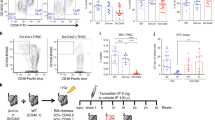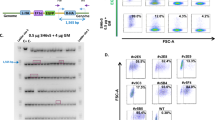Abstract
Chronic lymphocytic leukemia (CLL) consists of at least two major prognostic subgroups, characterized by different cellular and molecular markers. This observation sparked studies on the function and clinical importance of these markers. In order to address their function adequately, an efficient and reliable method for gene transfer is needed. In this study, we compared efficiency and utility of different gene transfer techniques in CLL. Lenti-, retro- and adenoviral transduction did not yield appreciable numbers of marker gene enhanced green fluorescent protein (EGFP) positive CLL cells, despite various prestimulation protocols. Efficient transgene expression was observed after nucleofection of CLL cells with plasmid DNA, at the expense of low survival rates. After optimization, electroporation of in vitro transcribed mRNA yielded up to 90% EGFP+CLL cells without affecting survival. Transgene expression remained detectable for at least 2 weeks after electroporation. Furthermore, we could demonstrate overexpression of ZAP70 and of a ZAP70-EGFP fusion protein after electroporation with ZAP70 or ZAP70-EGFP mRNA. We conclude that mRNA electroporation is a novel and straightforward method for highly efficient gene transfer in CLL. The application of this technique should facilitate functional studies on CLL cells, as well as clinical research.
This is a preview of subscription content, access via your institution
Access options
Subscribe to this journal
Receive 12 print issues and online access
$259.00 per year
only $21.58 per issue
Buy this article
- Purchase on Springer Link
- Instant access to full article PDF
Prices may be subject to local taxes which are calculated during checkout




Similar content being viewed by others
References
Molica S, Alberti A . Prognostic value of the lymphocyte doubling time in chronic lymphocytic leukemia. Cancer 1987; 60: 2712–2716.
Montserrat E, Sanchez-Bisono J, Vinolas N, Rozman C . Lymphocyte doubling time in chronic lymphocytic leukaemia: analysis of its prognostic significance. Br J Haematol 1986; 62: 567–575.
Dohner H, Stilgenbauer S, Benner A, Leupolt E, Krober A, Bullinger L et al. Genomic aberrations and survival in chronic lymphocytic leukemia. N Engl J Med 2000; 343: 1910–1916.
Stilgenbauer S, Bullinger L, Lichter P, Dohner H . Genetics of chronic lymphocytic leukemia: genomic aberrations and V(H) gene mutation status in pathogenesis and clinical course. Leukemia 2002; 16: 993–1007.
Damle RN, Wasil T, Fais F, Ghiotto F, Valetto A, Allen SL et al. Ig V gene mutation status and CD38 expression as novel prognostic indicators in chronic lymphocytic leukemia. Blood 1999; 94: 1840–1847.
Hamblin TJ, Davis Z, Gardiner A, Oscier DG, Stevenson FK . Unmutated Ig V(H) genes are associated with a more aggressive form of chronic lymphocytic leukemia. Blood 1999; 94: 1848–1854.
Crespo M, Bosch F, Villamor N, Bellosillo B, Colomer D, Rozman M et al. ZAP-70 expression as a surrogate for immunoglobulin-variable-region mutations in chronic lymphocytic leukemia. N Engl J Med 2003; 348: 1764–1775.
Wiestner A, Rosenwald A, Barry TS, Wright G, Davis RE, Henrickson SE et al. ZAP-70 expression identifies a chronic lymphocytic leukemia subtype with unmutated immunoglobulin genes, inferior clinical outcome, and distinct gene expression profile. Blood 2003; 101: 4944–4951.
Caligaris-Cappio F, Hamblin TJ . B-cell chronic lymphocytic leukemia: a bird of a different feather. J Clin Oncol 1999; 17: 399–408.
Cantwell MJ, Sharma S, Friedmann T, Kipps TJ . Adenovirus vector infection of chronic lymphocytic leukemia B cells. Blood 1996; 88: 4676–4683.
Huang MR, Olsson M, Kallin A, Pettersson U, Totterman TH . Efficient adenovirus-mediated gene transduction of normal and leukemic hematopoietic cells. Gene Ther 1997; 4: 1093–1099.
Kato K, Cantwell MJ, Sharma S, Kipps TJ . Gene transfer of CD40-ligand induces autologous immune recognition of chronic lymphocytic leukemia B cells. J Clin Invest 1998; 101: 1133–1141.
Wierda WG, Cantwell MJ, Woods SJ, Rassenti LZ, Prussak CE, Kipps TJ . CD40-ligand (CD154) gene therapy for chronic lymphocytic leukemia. Blood 2000; 96: 2917–2924.
Kofler DM, Buning H, Mayr C, Bund D, Baumert J, Hallek M et al. Engagement of the B-cell antigen receptor (BCR) allows efficient transduction of ZAP-70-positive primary B-CLL cells by recombinant adeno-associated virus (rAAV) vectors. Gene Ther 2004; 11: 1416–1424.
Theiss HD, Kofler DM, Buning H, Aldenhoff AL, Kaess B, Decker T et al. Enhancement of gene transfer with recombinant adeno-associated virus (rAAV) vectors into primary B-cell chronic lymphocytic leukemia cells by CpG-oligodeoxynucleotides. Exp Hematol 2003; 31: 1223–1229.
Wendtner CM, Kofler DM, Theiss HD, Kurzeder C, Buhmann R, Schweighofer C et al. Efficient gene transfer of CD40 ligand into primary B-CLL cells using recombinant adeno-associated virus (rAAV) vectors. Blood 2002; 100: 1655–1661.
Gresch O, Engel FB, Nesic D, Tran TT, England HM, Hickman ES et al. New non-viral method for gene transfer into primary cells. Methods 2004; 33: 151–163.
Munkonge FM, Dean DA, Hillery E, Griesenbach U, Alton EW . Emerging significance of plasmid DNA nuclear import in gene therapy. Adv Drug Deliv Rev 2003; 55: 749–760.
Shimokawa T, Okumura K, Ra C . DNA induces apoptosis in electroporated human promonocytic cell line U937. Biochem Biophys Res Commun 2000; 270: 94–99.
Gordillo GM, Xia D, Mullins AN, Bergese SD, Orosz CG . Gene therapy in transplantation: pathological consequences of unavoidable plasmid contamination with lipopolysaccharide. Transpl Immunol 1999; 7: 83–94.
Bonehill A, Heirman C, Tuyaerts S, Michiels A, Zhang Y, van der Bruggen P et al. Efficient presentation of known HLA class II-restricted MAGE-A3 epitopes by dendritic cells electroporated with messenger RNA encoding an invariant chain with genetic exchange of class II-associated invariant chain peptide. Cancer Res 2003; 63: 5587–5594.
Dullaers M, Breckpot K, Van Meirvenne S, Bonehill A, Tuyaerts S, Michiels A et al. Side-by-side comparison of lentivirally transduced and mRNA-electroporated dendritic cells: implications for cancer immunotherapy protocols. Mol Ther 2004; 10: 768–779.
Michiels A, Tuyaerts S, Bonehill A, Corthals J, Breckpot K, Heirman C et al. Electroporation of immature and mature dendritic cells: implications for dendritic cell-based vaccines. Gene Ther 2005; 12: 772–782.
Van Tendeloo VF, Ponsaerts P, Lardon F, Nijs G, Lenjou M, Van Broeckhoven C et al. Highly efficient gene delivery by mRNA electroporation in human hematopoietic cells: superiority to lipofection and passive pulsing of mRNA and to electroporation of plasmid cDNA for tumor antigen loading of dendritic cells. Blood 2001; 98: 49–56.
Smits E, Ponsaerts P, Lenjou M, Nijs G, Van Bockstaele DR, Berneman ZN et al. RNA-based gene transfer for adult stem cells and T cells. Leukemia 2004; 18: 1898–1902.
Coughlin CM, Vance BA, Grupp SA, Vonderheide RH . RNA-transfected CD40-activated B cells induce functional T-cell responses against viral and tumor antigen targets: implications for pediatric immunotherapy. Blood 2004; 103: 2046–2054.
Van den Bosch GA, Ponsaerts P, Nijs G, Lenjou M, Vanham G, Van Bockstaele DR et al. Ex vivo induction of viral antigen-specific CD8 T cell responses using mRNA-electroporated CD40-activated B cells. Clin Exp Immunol 2005; 139: 458–467.
Stove V, Van de Walle I, Naessens E, Coene E, Stove C, Plum J et al. Human immunodeficiency virus Nef induces rapid internalization of the T-cell coreceptor CD8alphabeta. J Virol 2005; 79: 11422–11433.
Taghon T, Stolz F, De Smedt M, Cnockaert M, Verhasselt B, Plum J et al. HOX-A10 regulates hematopoietic lineage commitment: evidence for a monocyte-specific transcription factor. Blood 2002; 99: 1197–1204.
Brummelkamp TR, Bernards R, Agami R . A system for stable expression of short interfering RNAs in mammalian cells. Science 2002; 296: 550–553.
Ponsaerts P, Van Tendeloo VF, Cools N, Van Driessche A, Lardon F, Nijs G et al. mRNA-electroporated mature dendritic cells retain transgene expression, phenotypical properties and stimulatory capacity after cryopreservation. Leukemia 2002; 16: 1324–1330.
Van Bockstaele F, Janssens A, Piette A, Callewaert F, Pede V, Offner F et al. Kolmogorov-Smirnov statistical test for analysis of ZAP-70 expression in B-CLL, compared with quantitative PCR and IgV(H) mutation status. Cytometry B Clin Cytom 2006; 70: 302–308.
Castro JE, Prada CE, Loria O, Kamal A, Chen L, Burrows FJ et al. ZAP-70 is a novel conditional heat shock protein 90 (Hsp90) client: inhibition of Hsp90 leads to ZAP-70 degradation, apoptosis, and impaired signaling in chronic lymphocytic leukemia. Blood 2005; 106: 2506–2512.
Chen L, Apgar J, Huynh L, Dicker F, Giago-McGahan T, Rassenti L et al. ZAP-70 directly enhances IgM signaling in chronic lymphocytic leukemia. Blood 2005; 105: 2036–2041.
Dicker F, Kater AP, Prada CE, Fukuda T, Castro JE, Sun G et al. CD154 induces p73 to overcome the resistance to apoptosis of chronic lymphocytic leukemia cells lacking functional p53. Blood 2006; 108: 3450–3457.
Endo T, Nishio M, Enzler T, Cottam HB, Fukuda T, James DF et al. BAFF and APRIL support chronic lymphocytic leukemia B-cell survival through activation of the canonical NF-kappaB pathway. Blood 2007; 109: 703–710.
Gobessi S, Laurenti L, Longo PG, Sica S, Leone G, Efremov DG . ZAP-70 enhances B-cell-receptor signaling despite absent or inefficient tyrosine kinase activation in chronic lymphocytic leukemia and lymphoma B cells. Blood 2007; 109: 2032–2039.
Longo PG, Laurenti L, Gobessi S, Petlickovski A, Pelosi M, Chiusolo P et al. The Akt signaling pathway determines the different proliferative capacity of chronic lymphocytic leukemia B-cells from patients with progressive and stable disease. Leukemia 2007; 21: 110–120.
Tiwari S, Dong H, Kim EJ, Weintraub L, Epstein PM, Lerner A . Type 4 cAMP phosphodiesterase (PDE4) inhibitors augment glucocorticoid-mediated apoptosis in B cell chronic lymphocytic leukemia (B-CLL) in the absence of exogenous adenylyl cyclase stimulation. Biochem Pharmacol 2005; 69: 473–483.
Li LH, Biagi E, Allen C, Shivakumar R, Weiss JM, Feller S et al. Rapid and efficient nonviral gene delivery of CD154 to primary chronic lymphocytic leukemia cells. Cancer Gene Ther 2006; 13: 215–224.
van den Hoff MJ, Moorman AF, Lamers WH . Electroporation in ‘intracellular’ buffer increases cell survival. Nucleic Acids Res 1992; 20: 2902.
Sloan-Lancaster J, Zhang W, Presley J, Williams BL, Abraham RT, Lippincott-Schwartz J et al. Regulation of ZAP-70 intracellular localization: visualization with the green fluorescent protein. J Exp Med 1997; 186: 1713–1724.
Acknowledgements
This work was supported by Grant No G.0026.06 from the Research Foundation—Flanders (FWO-Vlaanderen), Grant No 01J02006 from the Bijzonder Onderzoeksfonds from Ghent University and Grant 2007 from Centrum voor Gezwelziekten, Ghent University Hospital and the Interuniversity Attraction Poles Programme—Belgian State—Belgian Science Policy. BV is a Senior Clinical Investigator and FVB is a Research Assistant of the Research Foundation—Flanders (FWO-Vlaanderen). We thank Dr Fritz Offner and Dr Ann Janssens for providing blood samples, Dr Nathalie Cools for critical reading of the manuscript, Christian De Boever for help with artwork and Drs Reuven Agami, Chiara Bonini, Laure Coulombel, Dimitar Efremov, Eli Gilboa, Harry Heimberg, Lawrence Samelson, Hergen Spits, Kris Thielemans, Mireille Van Gele and Juan-Carlos Zùñiga-Pflücker for providing cell lines and research reagents. The personnel of the Aids Reference Laboratory kindly provided technical assistance with sequencing.
Author information
Authors and Affiliations
Corresponding author
Additional information
The work was done in Ghent University Hospital, Ghent, Belgium and Antwerp University Hospital, Edegem, Belgium.
Note added in proof
While this manuscript was in review, a paper appeared in Leukemia (Seiffert M, Stilgenbauer S, Döhner H and Lichter P. Efficient nucleofection of primary human B cells and B-CLL cells induces apoptosis which depends on the microenvironment and on the structure of transfected nucleic acids. Leukemia 2007; 21:1977–83.), that confirms increased cell mortality after nucleofection with plasmid DNA. Furthermore, these authors also reported transfection efficiencies of 80–90% after nucleofection of EGFP mRNA.
Supplementary Information accompanies the paper on the Leukemia website (http://www.nature.com/leu)
Rights and permissions
About this article
Cite this article
Van Bockstaele, F., Pede, V., Naessens, E. et al. Efficient gene transfer in CLL by mRNA electroporation. Leukemia 22, 323–329 (2008). https://doi.org/10.1038/sj.leu.2405007
Received:
Revised:
Accepted:
Published:
Issue Date:
DOI: https://doi.org/10.1038/sj.leu.2405007
Keywords
This article is cited by
-
The cellular response to plasma membrane disruption for nanomaterial delivery
Nano Convergence (2022)
-
Mimicking the tumour microenvironment of chronic lymphocytic leukaemia in vitro critically depends on the type of B-cell receptor stimulation
British Journal of Cancer (2016)
-
Disruption of autophagy by the histone deacetylase inhibitor MGCD0103 and its therapeutic implication in B-cell chronic lymphocytic leukemia
Leukemia (2014)
-
Induction of cytotoxic T lymphocytes primed with Tumor RNA-loaded Dendritic Cells in esophageal squamous cell carcinoma: preliminary step for DC vaccine design
BMC Cancer (2010)



